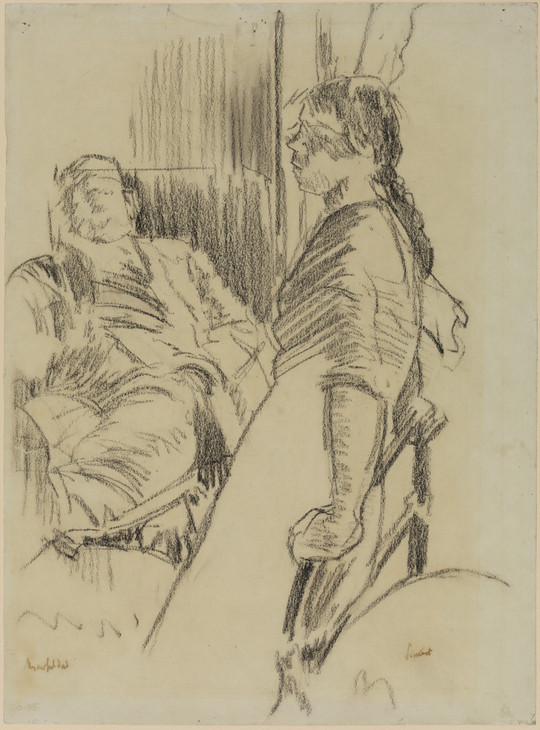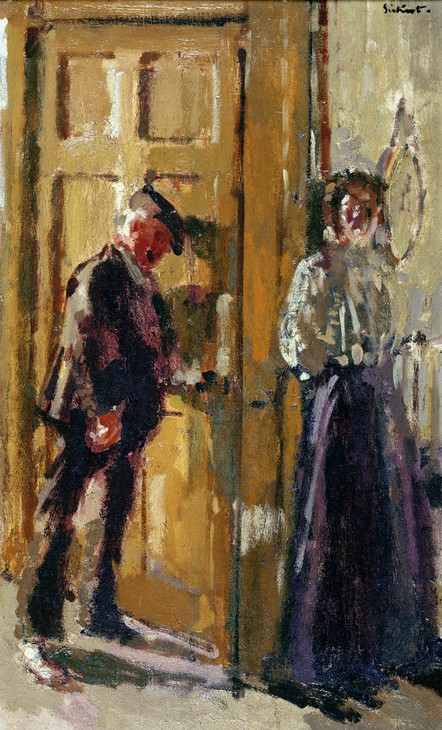Walter Richard Sickert Off to the Pub 1911
Walter Richard Sickert,
Off to the Pub
1911
This painting shows the figure of a man in the act of leaving a tawdry mustard and brown interior, presumably for the pub, as given in the title. A woman seen in profile seated stoically appears to stare vacantly after him, and wears the flat straw hat of the costermonger, signifying her stereotypically grim urban working class experience. At the time, Sickert was engaged in capturing pairs of figures arranged variously within domestic settings to produce emotional or psychological tension, as in the melodramatic crisis portrayed here, which culminated a few years later in Ennui c.1914 (Tate N03846).
Walter Richard Sickert 1860–1942
Off to the Pub
1911
Oil paint on canvas
508 x 406 mm
Inscribed by the artist ‘Sickert.’ in black paint bottom right
Presented by Howard Bliss 1943
N05430
1911
Oil paint on canvas
508 x 406 mm
Inscribed by the artist ‘Sickert.’ in black paint bottom right
Presented by Howard Bliss 1943
N05430
Ownership history
... ; bought by Howard Bliss by 1940 (but probably much earlier), by whom presented to Tate Gallery 1943.
Exhibition history
1911
?Dunmow Artists’ Picture Show, Dunmow, November 1911 (no catalogue).
1937–8
Walter Richard Sickert: An Exhibition of Paintings, Department of Fine Arts, Carnegie Institute, Pittsburgh, November 1937–February 1938 (15).
1938
Paintings by Walter Richard Sickert, Arts Club of Chicago, January 1938 (17).
1940
Richard Sickert, Redfern Gallery, London, February–March 1940 (18, lent by Howard Bliss).
1960
11th Hintlesham Summer Festival, Hintlesham Hall, Ipswich, July–August 1960 (no catalogue found).
1989–90
W.R. Sickert: Drawings and Paintings 1890–1942, Tate Gallery, Liverpool, March 1989–February 1990, Tate Gallery, London, July–September 1990 (8, reproduced).
1998–9
An Ordinary Life: Camden Town Painters, Aberdeen Art Gallery, November 1998–January 1999 (35).
2004
Walter Richard Sickert: The Human Canvas, Abbot Hall Art Gallery, Kendal, July–October 2004 (24, reproduced).
2008
Modern Painters: The Camden Town Group, Tate Britain, London, February–May 2008 (45, reproduced).
2010
The Art of Walter Sickert, The Lightbox, Woking, May–July 2010 (no catalogue).
References
1955
Anthony Bertram, Sickert, London and New York 1955, p.9, reproduced pl.29.
1960
Lillian Browse, Sickert, London 1960, pp.76, 101.
1960
Wendy Dimson, ‘Four Sickert Exhibitions’, Burlington Magazine, vol.102, no.691, October 1960, p.443.
1964
Mary Chamot, Dennis Farr and Martin Butlin, Tate Gallery Catalogues: The Modern British Paintings, Drawings and Sculpture, vol.2, London 1964, p.636.
1973
Wendy Baron, Sickert, London 1973, pp.125, 353–4, no.296, reproduced pl.205.
1976
A Terrific Thing: British Art 1910–16, exhibition catalogue, Norwich Castle Museum 1976, p.3.
1979
Wendy Baron, The Camden Town Group, London 1979, p.390.
1980
Simon Watney, English Post-Impressionism, London 1980, p.138, reproduced fig.73 and p.1 (detail).
1990
Richard Shone, From Beardsley to Beaverbrook: Portraits by Walter Richard Sickert, exhibition catalogue, Victoria Art Gallery, Bath 1990, p.6.
1992
Wendy Baron and Richard Shone (eds.), Sickert: Paintings, exhibition catalogue, Royal Academy, London 1992, p.216, reproduced fig.155.
2000
Wendy Baron, Perfect Moderns: A History of the Camden Town Group, Aldershot and Vermont 2000, p.205.
2001
David Peters Corbett, Walter Sickert, London 2001, p.32, reproduced fig.24.
2001
Alison Smith (ed.), Exposed: The Victorian Nude, exhibition catalogue, Tate Britain, London 2001, p.265 under no.175.
2006
Wendy Baron, Sickert: Paintings and Drawings, New Haven and London 2006, no.367, p.380, reproduced.
2011
William Rough, ‘Walter Sickert and Contemporary Drama’, The Camden Town Group, Tate 2011, http://www.tate.org.uk.
Technique and condition
Walter Sickert bought his canvas from the local colourman P. Shea; he chose plain open-weave linen, sized and fully primed with a white primer composed of a layer of chalk and kaolin with a more opaque layer of lead white and chalk on top.1 Sickert painted directly onto the white priming initially defining the composition in blue paint, which he left visible in many areas to form cool shadows and reflections. The canvas texture is very visible and it is possible that Sickert rubbed down the early stages of paint (see also Tate N03182). When this was dry he applied warm highlights of oranges, reds and pinks. The paint is applied thinly at first but building up in several applications to thick impasto in a few areas where he has left the load from his brush largely unworked on the painting surface. While much of the brushwork is coarse and the paint is stiffly brushed, bouncing across the texture underneath in the lighter areas of the legs, for example, in other areas the paint was more fluid on application. There is little evidence of reworking except for some modification to the sitter’s arm. A soft resin varnish of unknown origin has been thinly applied overall, which is now yellow and suppresses the blues in the painting.
Stephen Hackney
July 2004
Notes
How to cite
Stephen Hackney, 'Technique and Condition', July 2004, in Nicola Moorby, ‘Off to the Pub 1911 by Walter Richard Sickert’, catalogue entry, June 2009, in Helena Bonett, Ysanne Holt, Jennifer Mundy (eds.), The Camden Town Group in Context, Tate Research Publication, May 2012, https://wwwEntry
In the winter of 1903, during his time living in Venice, Sickert began painting a number of indoor scenes featuring two women in varying compositional arrangements (see Tate N03621 and N05296).1 Back in London, between 1907 and 1914, he once again experimented with figurative interiors but this time his images more usually combined a man and a woman. Initially, these paintings focused on the juxtaposition between a naked female and a fully dressed male, invoking the psychological tensions created by their association with the recent Camden Town murder in 1907. In later years, he went on to explore less controversial pairings of two clothed models, which nevertheless stimulated similar feelings of claustrophobic unease and anxiety within the viewer. He defined these works as ‘the dramatic truth in the modern conversation piece or genre picture’,2 and gave them titles suggestive of domestic disturbance and angst, for example, The Argument 1911 (Auckland Art Gallery, New Zealand),3 ‘That Boy Will Be The Death of Me’ c.1912 (private collection),4 My Awful Dad c.1912 (fig.1)5 and Ticking Him Off c.1913 (private collection).6 The series culminated with the quintessential image of dysfunctional home life, Ennui c.1914 (Tate N03846).

Walter Richard Sickert 1860–1942
My Awful Dad c.1912
Chalk on paper
248 x 347 mm
The Samuel Courtauld Trust, The Courtauld Gallery, London
© Estate of Walter R. Sickert / DACS
Photo © The Samuel Courtauld Trust, The Courtauld Gallery, London
Fig.1
Walter Richard Sickert
My Awful Dad c.1912
The Samuel Courtauld Trust, The Courtauld Gallery, London
© Estate of Walter R. Sickert / DACS
Photo © The Samuel Courtauld Trust, The Courtauld Gallery, London
Like many of Sickert’s figure paintings of this period, this work explores contemporary notions of class and social type, annexing and manipulating the prejudices of middle and upper class viewers.8 In paintings such as L’Américaine 1908 (Tate N05090), the artist had engaged with the traditional notion of the urban street-seller as a symbol of healthy and attractive vitality. Here, however, he exploits a more melodramatic stereotype of the female London costermonger as ill-used and unhappy. He relished the negative cliché of these women as victims, and in a letter to his friends, Ethel Sands and Nan Hudson, ghoulishly catalogued the abuses to which they were vulnerable: men ‘hitting them with hammers, putting poisonous powders on cakes, trying to cut their throats, drugging their whisky’.9 On another occasion he crowed, ‘London is spiffing! Such evil racy little faces & such a comfortable feeling of a solid basis of beef and beer. O the whiff of leather & stout from the swing-doors of the pubs!’10
One of the greatest vices ascribed to the working classes by their social superiors was alcoholism. Although statistics show that alcohol consumption and convictions for drunkenness fell during the period, the Edwardians inherited Victorian anxieties about the evils of drink among the working classes.11 Within this painting Sickert plays upon the viewer’s recognition of the two figures as lower class and conditions their response to the perceived scenario by calling it Off to the Pub. The title imposes a proverbial context that the artist fully intended to reference but for which the pictorial evidence does not in fact exist. There is no conclusive narrative content to confirm the anecdotal theme and the truth, like the physical details within the painted surface, is entirely ambiguous.
Although the painting belongs to a wider subset of pictures mythologising everyday life, the particular subject matter may have originated from real events. Off to the Pub appears to be the earliest to feature one of Sickert’s favourite models of the period, Hubby. An old school fellow who had fallen into petty crime, Hubby, whose real name is unknown, was taken into the artist’s employ in 1911 as a general factotum. Delighting in his ‘kind silly old face & his sympathetic pomposity’, Sickert also used him as the male protagonist in a number of pictures.12 With his distinctive round, moustachioed face and his sturdy, brown-suited physique he was cast in the role of a generic middle-aged man, down on his luck, most famously in Ennui (Tate N03846). In Off to the Pub he lurches with his hand on the doorknob through the doorway of an unpleasantly mustard and brown interior, away from the disconsolate figure of the coster-woman seated behind.
Hubby is known to have been an alcoholic and Sickert took to paying his wages to his wife to try to avoid him spending it on drink. Eventually, the situation became intolerable for Sickert and he was forced to let Hubby go. In the summer of 1914 he wrote to Nan Hudson:
I am somewhat shaken by the necessity I have been under of breaking my arrangement with poor old Hubby. I thought I held him tight by paying the missus. But I found he was getting money by other sources and he took to arriving silly-drunk which so far from being useful to me upset my whole day’s work & my nerves & makes my heart beat with anger and pity ... It is a great grief to me ... It is like a death, only worse ... Of course it means drink and, eventually prison. I have staved it off for a couple of years that is all.13
The last recorded fact about Hubby was that he enlisted in the army in 1914. Nothing more is known of his life beyond this.14
Sickert’s broken and patchy technique in this work is characteristic of his ‘Camden Town’ period, substituting painted detail for broader tonal effects and interlocking passages of dark and light. The art historian Wendy Baron has described the brushwork as ‘sweeping, smooth and broad’ and ‘an untidy fabric of short broad strokes, undisciplined by any drawn definition except for the occasional mark on the faces’.15 She argues that the handling of paint as well as Sickert’s use of a coster-woman within the composition dates Off to the Pub to 1911.16 Furthermore, she has identified it as the painting exhibited at the Dunmow Artist’s Picture Show in November 1911, a small show in Dunmow, Essex organised by Sickert’s brother, Bernhard.17 Local newspaper, the Essex Herald, described it as ‘very strongly executed’ and ‘a new line’ in ‘modern Impressionist art’.18

Walter Richard Sickert 1860–1942
Off to the Pub (The Week-End) 1912
Oil paint on canvas
489 x 292 mm
Leeds Museums and Galleries (City Art Gallery)
© Estate of Walter R. Sickert / DACS
Photo © Leeds Museums and Galleries (City Art Gallery) UK / The Bridgeman Art Library
Fig.2
Walter Richard Sickert
Off to the Pub (The Week-End) 1912
Leeds Museums and Galleries (City Art Gallery)
© Estate of Walter R. Sickert / DACS
Photo © Leeds Museums and Galleries (City Art Gallery) UK / The Bridgeman Art Library
The painting was presented to the Tate Gallery by Howard Bliss, brother of the composer, Sir Arthur Bliss. Bliss was a modest but important collector of largely contemporary art. He started collecting in the 1940s and in addition to Sickert, owned work by Louis le Brocquy, John Piper, John Craxton and Terry Frost. He was a friend and significant patron of the painter, Ivon Hitchens, amassing the most important collection of work by that artist.
Nicola Moorby
June 2009
Notes
Walter Sickert, ‘A Monthly Chronicle. Maurice Asselin’, Burlington Magazine, 28 December 1915; quoted in Wendy Baron, ‘The Domestic Theatre’, in Walter Sickert: ‘drawing is the thing’, exhibition catalogue, Whitworth Art Gallery, Manchester 2004, p.6.
David Peters Corbett, ‘Modern Themes in Camden Town painting’, in Modern Painters: The Camden Town Group, exhibition catalogue, Tate Britain, London 2008, p.35.
Walter Sickert, letter to Nan Hudson and Ethel Sands, [August/September 1908], Tate Archive TGA 9125/5, no.36.
Related biographies
Related essays
How to cite
Nicola Moorby, ‘Off to the Pub 1911 by Walter Richard Sickert’, catalogue entry, June 2009, in Helena Bonett, Ysanne Holt, Jennifer Mundy (eds.), The Camden Town Group in Context, Tate Research Publication, May 2012, https://www


